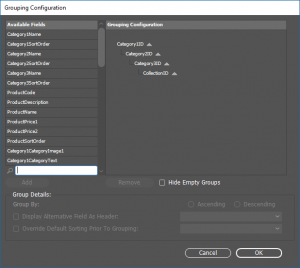The EasyCatalog panel presents your chosen catalog data in a grid view inside Adobe InDesign. This panel provides you with the functionality to setup your data hierarchy, format data types, add custom fields and to instigate the automated creation of catalog pages.

Table of Contents
Data Types
EasyCatalog supports loading data using a number of common formats:
- CSV file
- Excel file
- Google docs connection
- ODBC connection
- XML file
Additionally, EasyCatalog allows you to create a new relational database structure or to match an existing relational database.
Panel layout

- Panel name
- Data fields
- EasyCatalog panel flyout menu
- Group headings
- Icons
- Group arrows
View more information in our Navigating the EasyCatalog panel guide.
Managing data
Formatting data
A data field may be formatted as a number, currency or as HTML/formatted text. EasyCatalog also provides options to add a prefix or suffix, and to undertake an automated find/replace process known as data cleansing. Learn more about data cleansing in our Tidying your data with EasyCatalog data cleansing guide.
Creating custom fields
A custom field is a field that exists in the data panel but not within the source data.
Custom fields allow the conversion and manipulation of data; conditional setting of data values; and to assist with the control of items within a group hierarchy to assist in the creation of automated content.
Common custom fields include:
- CONCAT – Concatenate (join) separate strings
- DOESIMAGEEXIST – Test for existence of image
- GROUPISFIRST – Identify first n records
- IF – Test if any arguments are true
Refer the EasyCatalog Custom Fields reference guide for detailed information and examples of how to use each of the 90 EasyCatalog custom fields.
Grouping
EasyCatalog requires data to be grouped in order to produce hierarchical content. Typically, a group is added at each category level.

Updating data
A key feature of EasyCatalog is the ability to continually update product data (e.g. product descriptions, prices, image references) as these change during the elapsed catalog production process.
EasyCatalog also keeps track of any instances where the document and panel data aren’t in sync (as a result of updating the data or the document).